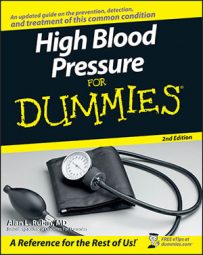Salt, which is made up of 40 percent sodium and 60 percent chloride, is critical to your life. You can't live without it. Sodium helps to maintain your blood's water content, serves to balance the acids and bases in your blood, and is necessary for the movement of electrical charges in the nerves that move our muscles.
It's generally believed that the inability of your kidney to excrete sodium is responsible for sodium-induced high blood pressure. By increasing blood pressure, more sodium is filtered by the kidney, enters the urine, and the body compensates for its inability to excrete sodium. This increased blood pressure helps to eliminate more sodium, but it also puts a strain on your arteries and sets the downward spiral of blood-pressure damage in motion — a vicious cycle.
The recommendation for sodium in the Dietary Guidelines for Americans from the U.S. Department of Health and Human Services as well as the American Heart Association is 2,400 milligrams (mg) daily for adults. This is about the amount in 1 teaspoon of salt (2,300 mg to be exact). The average American consumes 5,000 mg of sodium daily — twice the necessary amount. Normal sodium balance can be maintained with 500 mg daily (or a little more than one-fourth teaspoon of salt), so Americans are eating ten times as much as they really need. Canada, Australia, the United Kingdom, and Portugal all have about the same recommendation of 2,400 mg of sodium. Some countries, such as Germany (4,000 mg), the Netherlands (3,600 mg) and Belgium (3,500 mg), are more liberal and at least one country, Sweden (800 mg), is more restrictive than the United States.
"Where is all this sodium coming from?" you may ask. Many foods (such as meat and fish) are natural sources of sodium while others contain salt added during processing (prepared soup and crackers, for example).
Surprisingly, you're responsible for only 15 percent of the sodium in your diet. Food has about 10 percent of your sodium already naturally in it. The food industry is responsible for adding 75 percent of the sodium that you consume each day to the prepared foods that you buy. For example, the following additives contain plenty of sodium:
- Color Developer: Promotes the development of color in meats and sauerkraut.
- Fermentation Controller: Keeps organic action in check in cheeses, sauerkraut, and baked goods.
- Binder: Holds meat together as it cooks.
- Texture Aid: Allows dough to expand and not tear.
For these and other reasons, salt is part of food processing. It may not be for taste.
The only way that you can successfully reduce the sodium in your diet is by switching from processed foods to fresh foods or selecting low-salt processed foods.
Buying low-sodium foods
The Food and Drug Administration has definite guidelines as to the terms a food company can use when describing the sodium in the food on the label. Keep these terms in mind and make a point of buying low-salt foods on your next trip to the grocery store:
- Sodium free means less than 5 mg sodium in a portion.
- Very low sodium means less than 35 mg sodium in a portion.
- Low sodium means less than 140 mg sodium in a portion.
- Reduced sodium food contains 25 percent less sodium than the original food item.
- Light in sodium food has 50 percent less sodium than the original food item.
- Unsalted, No salt added, or Without added salt means absolutely no salt has been added to a food that's normally processed with salt.
Take time to read the Nutrition Facts label on food items. Avoid items that contain more than 180 milligrams of sodium.
Avoiding high-sodium foods
The following processed foods are particularly high in sodium. Steer clear of these heavily laced edibles as much as possible. Fortunately, after many years of urging and recommendations from health organizations, manufacturers have begun to lower the sodium in foods, so you may find several of these foods in a low-salt form. Check the food label.
- Anchovies
- Bacon
- Bouillon cubes
- Canned soup
- Canned tuna
- Canned vegetables
- Cheese
- Cold cuts
- Condiments
- Cooking sauces
- Cottage cheese
- Croutons
- Gravy
- Ham
- Hot dogs
- Olives
- Pickles
- Salad dressings
- Salsa
- Sausage
- Sea salt
- Soy sauce
- Spaghetti sauce
- Tomato or vegetable juice
Going on a low-sodium diet
Besides avoiding high-sodium foods, you can make a few other changes to lower your salt intake:
- Cook with herbs, spices, fruit juices, and vinegars for flavor rather than salt.
- Eat fresh vegetables.
- Keep the saltshaker in the kitchen cupboard rather than at the table, where it's so easy to use.
- Use less salt than the recipe calls for.
- Select low-salt canned foods or rinse your food with water.
- Select low-salt frozen dinners.
- Use high-salt condiments, such as ketchup and mustard, sparingly.
- Snack on fresh fruits rather than salted crackers or chips.
- When eating out, ask that your food be prepared with only a little salt. Request your salad dressing "on the side" of the salad, so you can control the amount that goes on it.
Be careful of salt substitutes. Some contain sodium. Check the label. You could end up eating so much of the substitute in an attempt to get that salty taste that your total sodium intake is just as high as using salt.

